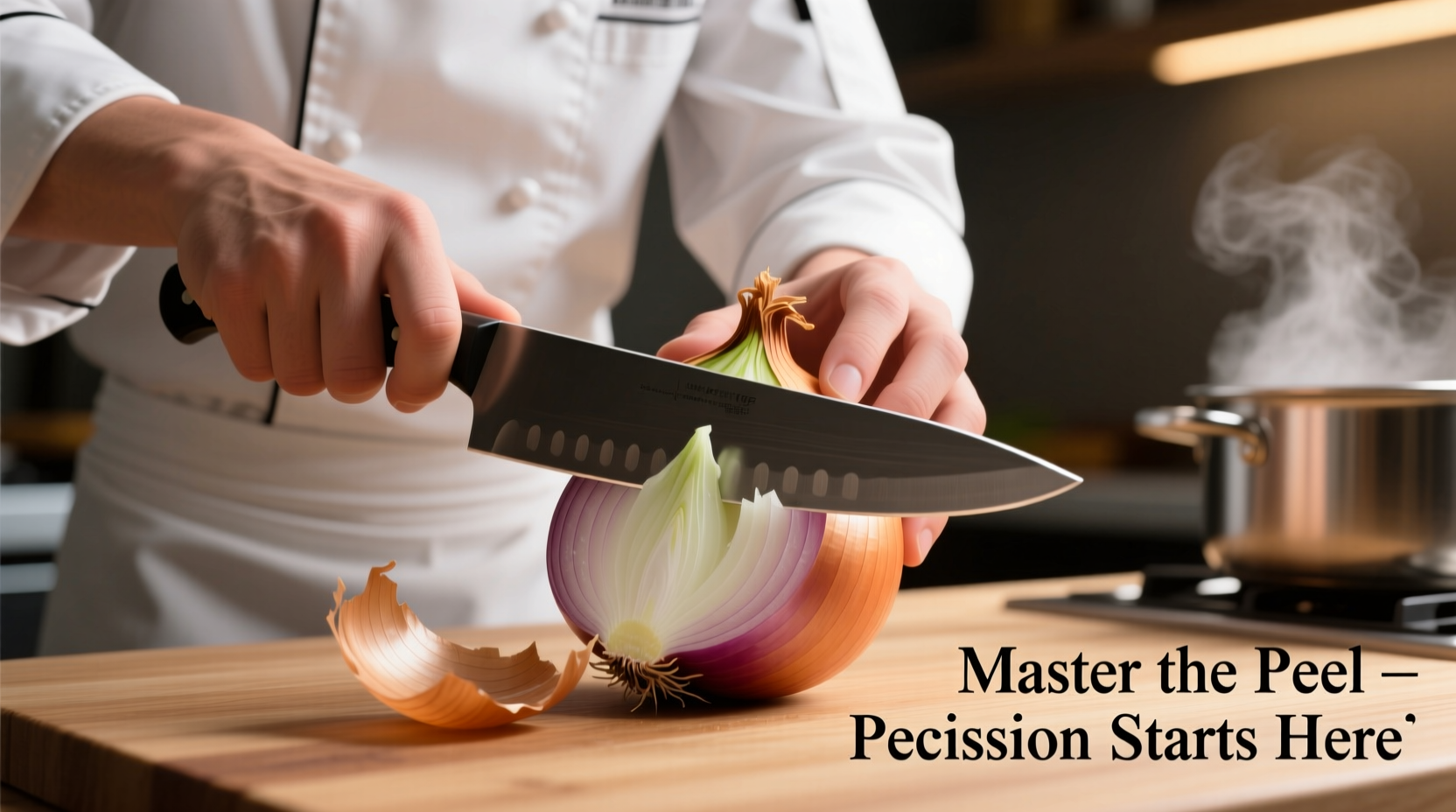Peeling onions seems simple, but improper technique leads to wasted time, lost flavor, and unnecessary tears. Whether you're preparing a quick weeknight dinner or professional kitchen service, mastering onion peeling transforms your cooking experience. This guide reveals science-backed methods used by professional chefs to handle onions efficiently while maximizing their culinary potential.
The Science Behind Onion Tears: A Chemical Timeline
When you cut through an onion's cell walls, you trigger a precise biochemical reaction. Understanding this process helps prevent tears:
| Time After Cutting | Chemical Process | Practical Implication |
|---|---|---|
| 0-5 seconds | Enzyme alliinase contacts sulfoxides | Immediate action prevents reaction start |
| 5-15 seconds | Formation of sulfenic acid | Cooling delays this conversion stage |
| 15-30 seconds | Propanethial S-oxide gas released | Gas reaches eyes causing irritation |
| 30+ seconds | Full tear-inducing concentration | Reaction becomes difficult to stop |
This enzymatic timeline explains why professional chefs emphasize speed and temperature control during onion preparation. The National Onion Association confirms that chilling onions before cutting slows the chemical reaction by up to 60%, significantly reducing tear production (onions-usa.org).
Essential Tools for Efficient Onion Peeling
While a sharp chef's knife remains indispensable, these specialized tools enhance your onion preparation:
- Ceramic knives - Create less cellular damage than steel, minimizing gas release
- Onion goggles - Food-safe protective eyewear with ventilation channels
- Microplane zester - For removing thin outer layers without waste
- Non-porous cutting boards - Prevent absorption of onion oils that intensify odors

Professional Onion Peeling Techniques by Application
Match your peeling method to your cooking purpose. Different techniques preserve varying amounts of flavor compounds and structural integrity:
Standard Peeling for General Cooking
- Cut 1/4 inch off both ends of the onion
- Score the outer layer vertically with shallow cuts
- Peel from the root end toward the stem
- Remove only the papery outer layers
- Rinse briefly under cold water to remove residual particles
Quick Peeling for Large Quantities
Commercial kitchens use this time-saving method when presentation isn't critical:
- Blanch whole onions in boiling water for 30 seconds
- Transfer immediately to ice water bath
- Squeeze from root end to push out flesh
- Discard loosened skins
This technique works best with yellow storage onions but isn't recommended for sweet varieties like Vidalias, which become too soft. The University of California Cooperative Extension confirms this method reduces preparation time by 40% while maintaining nutritional content (ucanr.edu).
Creative Uses for Onion Peels You Shouldn't Discard
Most home cooks immediately discard onion skins, but these contain valuable compounds:
- Natural food coloring - Simmer red onion skins in water for 20 minutes to create vibrant pink dye for eggs or rice
- Nutrient-rich broth - Add to vegetable stock for depth of flavor (onion skins contain quercetin, a powerful antioxidant)
- Compost accelerator - High sulfur content speeds decomposition
- Plant fertilizer - Steep in water for 48 hours to create nutrient solution for houseplants
Research from the Journal of Agricultural and Food Chemistry shows onion skins contain up to 20 times more quercetin than the flesh, making them valuable for health-conscious cooking (pubs.acs.org).
Proper Storage of Peeled Onions
Maximize freshness with these storage guidelines:
- Store in airtight container with paper towel to absorb moisture
- Refrigerate at 32-34°F (0-1°C) for optimal shelf life
- Consume within 7-10 days for best flavor retention
- Never store peeled onions near potatoes—they accelerate spoilage
Food safety experts at the USDA confirm that properly stored peeled onions maintain quality for up to 10 days, while improperly stored onions develop off-flavors within 3 days (fsis.usda.gov).
Avoid These Common Onion Peeling Mistakes
Even experienced cooks make these errors that compromise flavor and safety:
- Using dull knives - Crushes cells, releasing more tear-inducing compounds
- Peeling too deeply - Removes flavorful outer flesh layers containing highest concentration of sulfur compounds
- Leaving peeled onions at room temperature - Accelerates enzymatic browning and flavor loss
- Cutting root end first - Releases maximum gas; always cut stem end first
FAQ: Frequently Asked Questions About Onion Peeling
Does chilling onions before cutting really prevent tears?
Yes, chilling onions to 32-40°F (0-4°C) for 30 minutes before cutting slows the enzymatic reaction that creates tear-inducing compounds by up to 60%. The cold temperature reduces the volatility of the sulfur compounds, preventing them from becoming airborne as quickly.
Can I use onion peels in cooking without affecting flavor?
Yes, when used properly. Simmer onion skins in stocks or broths for 20-30 minutes to extract nutrients and color without bitterness. Remove before serving as prolonged cooking can create astringent flavors. Avoid using in delicate dishes where color would be problematic.
Why do some onions make me cry more than others?
Tear production varies by onion type and growing conditions. Yellow storage onions contain the highest concentration of syn-propanethial-S-oxide (the tear compound). Sweet onions like Vidalias have lower sulfur content, while red onions fall in between. Onions grown in sulfur-rich soil produce more tear-inducing compounds.
How can I prevent my hands from smelling like onions after peeling?
Rub hands with stainless steel under cold water, which neutralizes sulfur compounds through a redox reaction. Alternatively, use a paste of baking soda and water, or rub with lemon juice. Wearing thin food-safe gloves provides the most effective barrier while maintaining dexterity.











 浙公网安备
33010002000092号
浙公网安备
33010002000092号 浙B2-20120091-4
浙B2-20120091-4